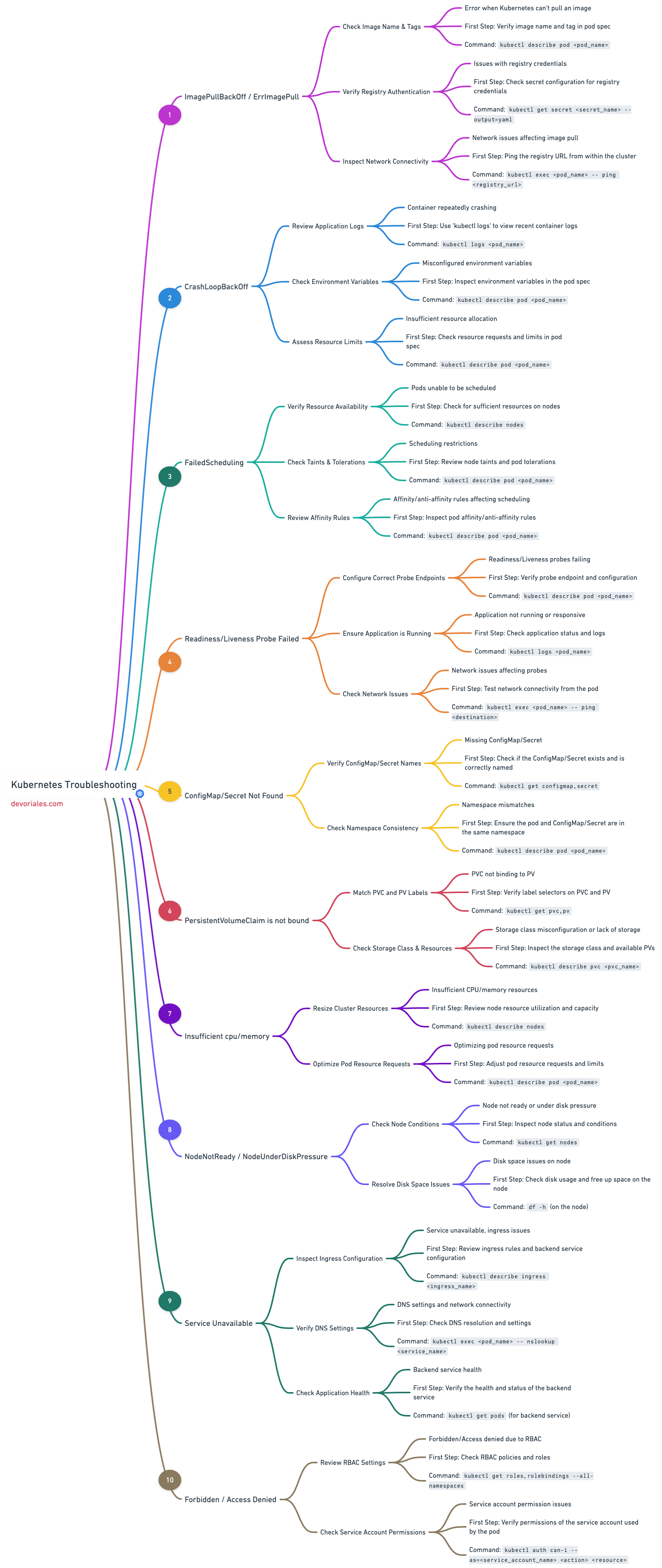
Kubernetes: Tackling the 10 Common Error Messages Diagram

For Kubernetes administrators and engineers, the concept of a 'quiet holiday season' is more mythical than Santa himself 🎅🎄😂
The following diagram visualizes the ten most common errors in Kubernetes and approaches you could take.
It also shows some basic commands you could use as a starting point:

A bit of details:
| Step | Error Message | Command to Use for Troubleshooting | Problem Description |
|---|---|---|---|
| 1 | ImagePullBackOff / ErrImagePull | kubectl describe pod <pod_name> |
Occurs when Kubernetes is unable to pull a container image from the registry, possibly due to wrong image name, tag, or registry issues. |
| 2 | CrashLoopBackOff | kubectl logs <pod_name> |
Happens when a container repeatedly crashes after starting, often due to application errors or misconfiguration. |
| 3 | FailedScheduling | kubectl get events |
Indicates that Kubernetes is unable to schedule a pod, usually because of resource constraints or scheduling restrictions. |
| 4 | Readiness/Liveness Probe Failed | kubectl describe pod <pod_name> |
This error suggests that the readiness or liveness probes for a pod are failing, which could be due to the application not being ready or healthy. |
| 5 | ConfigMap/Secret Not Found | kubectl get configmap,secret |
This occurs when a referenced ConfigMap or Secret is missing, often due to naming or namespace mismatches. |
| 6 | PersistentVolumeClaim is not bound | kubectl get pvc,pv |
Arises when a PVC cannot bind to a PV, possibly due to storage class misconfiguration or lack of available storage. |
| 7 | Insufficient cpu/memory | kubectl describe nodes |
This error indicates that there are insufficient CPU or memory resources in the cluster to meet the pod's requests. |
| 8 | NodeNotReady / NodeUnderDiskPressure | kubectl get nodes |
Suggests that a node is not ready to accept pods or is under disk pressure, potentially due to resource exhaustion or health issues. |
| 9 | Service Unavailable | kubectl describe ingress <name> |
This typically indicates issues with accessing services, often related to ingress configuration or backend service problems. |
| 10 | Forbidden / Access Denied | kubectl auth can-i <action> <resource> |
Implies RBAC permission issues, where the user or service account lacks the necessary permissions for an action. |
Remember, it's not DNS 😂.
About the Author
Aleksandro Matejic, a Cloud Architect, began working in the IT industry over 21 years ago as a technical specialist, right after his studies. Since then, he has worked in various companies and industries in various system engineer and IT architect roles. He currently works on designing Cloud solutions, Kubernetes, and other DevOps technologies.
In his spare time, Aleksandro works on different development projects such as developing devoriales.com, a blog and learning platform launching in 2022/2023. In addition, he likes to read and write technical articles about software development and DevOps methods and tools.
You can contact Aleksandro by visiting his LinkedIn Profile